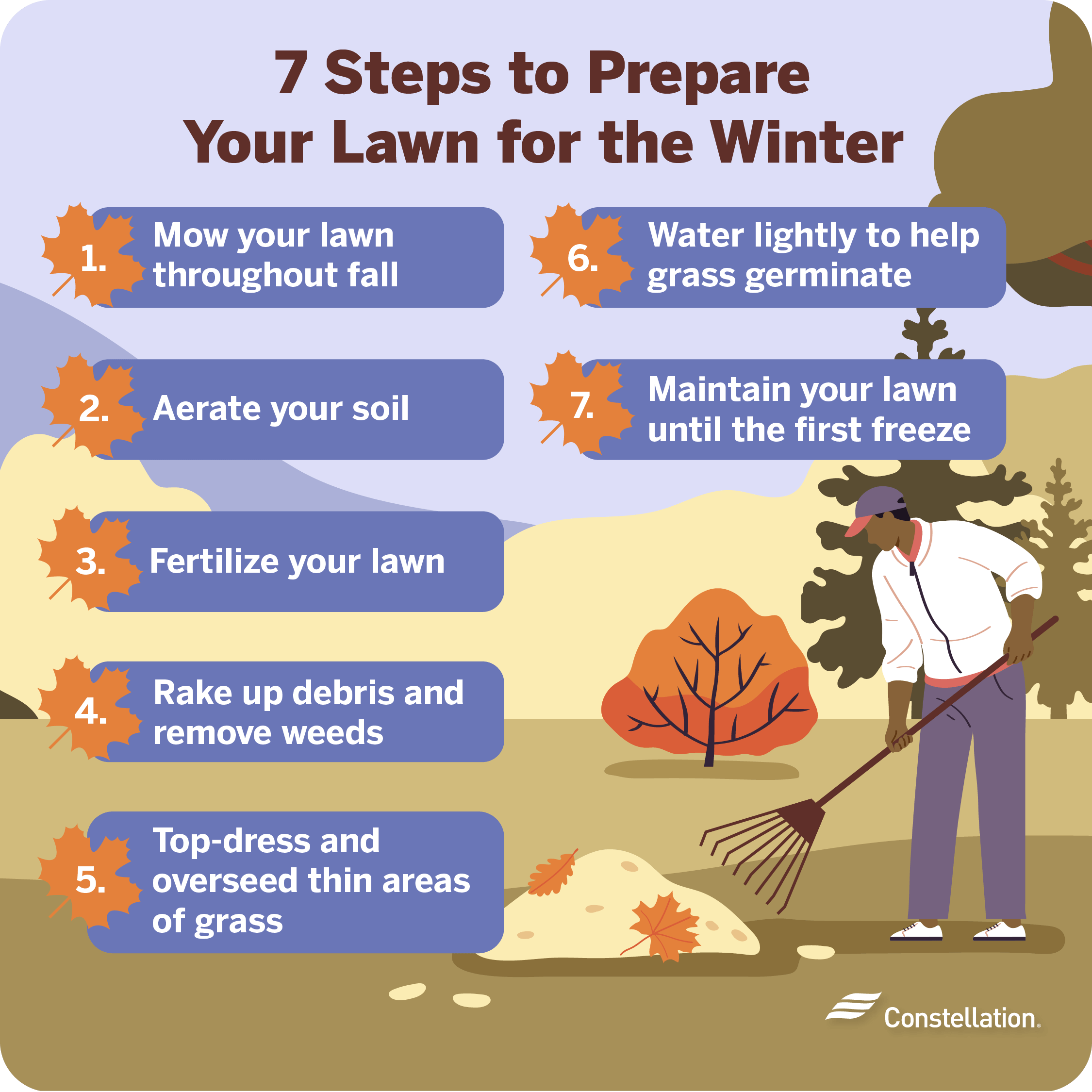
- Category:
Home Energy Savings -
Last updated:
October 5, 2023
How to Prepare Your Lawn for Winter
Preparing your lawn for winter will help it thrive through the changing seasons. You can ensure a lush and healthy landscape if you know how to prepare a lawn for winter. It takes less effort and requires fewer inputs, like water, fertilizers, and chemicals to fight weeds and lawn diseases. You’ll find a little preparation helps you keep your costs down. If you get ahead of the work this season, you can kick back more often and enjoy your property all year round.
7 steps to prepare your lawn for the winter

As is so frequently the case, preparing and working ahead is easier and cheaper than reacting after you have a problem. That is especially the case when it comes to your lawn. Here are some things you can do this fall, not only to prepare grass for winter, but to ensure it looks fantastic come spring.
1. Mow your lawn throughout fall
Continue to cut your grass regularly in the fall to protect it from the coming cold. Leaving it too long will create breeding ground for lawn diseases caused by fungi and bacteria. That said, grass grows slower in the fall, so you won’t need to mow it as often. Let your eyes be your guide. The ideal height for your lawn is to keep your grass at about two and a half inches high before a frost or a snow fall.
2. Aerate your soil
A critical step in lawn care before winter is making sure water, air and nutrients can penetrate through the sod into your soil. You will want a special tool that either slices into your soil with spikes or punches holes in it at regular intervals.
You can buy inexpensive hand aerators, but the job is easier if you rent a power tool for the day. Choose a time when your soil is soft and moist, yet not soaked through and muddy.
3. Fertilize your lawn
After a summer of stress from heat, insects and trampling feet, your lawn is ready for some nutrition. The next few months are a chance for grass to grow new roots and thicken up, making it an ideal time to fertilize.
Your county extension may have free soil tests or you can buy them at a garden center. Apply the right amount of nitrogen, phosphorus and potassium using a spreader for even coverage, based on your test results. Applying a compost is a natural and renewable way to support your lawn.
4. Rake up debris and remove weeds
Rake leaves frequently to prevent them from smothering your lawn. While it is tempting to wait and do the job once, you will stress the grass underneath just when it needs to thicken up for winter. Remove debris for the same reason and keep an eye out for weeds.
Manually removing weeds is more work, but you will minimize the herbicides you would otherwise have to apply. Preparing your lawn for winter in this way, your grass will not have to compete or struggle. It can come back to life more robustly in the spring.
5. Top-dress and overseed thin areas of grass
You can thicken your grass as part of preparing your lawn for winter by sprinkling a layer of sand, topsoil, or compost on top of it. Again, a spreader makes the job easy, but you can also use a shovel to manually spread the material.
Mow the grass to be as short as possible early in the fall. Add grass seed, particularly in areas that are thinning or damaged. Carefully spread your top dressing from a quarter to half inch deep. Then finish the job with a light watering.
6. Water lightly to help grass germinate
Depending on your weather, you may want to water your lawn as a regular part of preparing grass for winter. If you are getting regular rain, your lawn probably doesn’t need the support, but if you are going weeks at a time without it, your lawn will be grateful for the help.
Watering is particularly necessary if you have reseeded your lawn. Use a gentle sprinkler so that you don’t wash grass seeds away. Taper down on watering a few weeks before the first frost is predicted.
7. Maintain a good growing environment until the first hard freeze
Keep the previous tips in mind and adjust your lawn care accordingly before winter. From regularly raking fallen leaves to cutting and watering your grass, you’ll be able to see what it needs–or doesn’t. Preparing your lawn for winter takes more than performing any one task; it takes paying attention to the specific conditions on your property. Keep up your maintenance tasks until the first hard freeze sends your lawn into a dormant state until spring.
Additional ways to prepare your outdoor space for winter
Use these tips for how to prepare your lawn for winter for other parts of your yard. Planting perennials and flowers that bloom in spring. Check your shrubs and trees, trimming dead areas and adding nutrients. Adding mulch is a good winter storm prep that will protect their roots through the bitter days to come and ensures they have even moisture through the coming season. You insulate your home, so why not insulate your plantings, too? Mulch, like compost, is a natural and renewable soil amendment.
Learn more about preparing your home for winter
Preparing your lawn for winter is really part of preparing your whole home for winter. Take the time to consider things you can do around your house and in your garage.
The article, Preparing Your Home for Winter in 11 Steps, is a good place to start. You will find practical ideas for improvements and projects that you can start lining up your fall preparations and researching cheap ways to heat your home. And don’t forget to prepare your car for winter, too.




